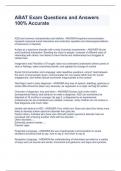ABAT Exam Questions and Answers 100% Accurate
ASD and common characteristics and deficits - ANSWER-impaired communication, impaired reciprocal social interaction and restricted, repetitive and stereotyped patterns of behaviors or interests.
Autism as a spectrum disorder with a triad of primary impairments - ANSWER-Social and Emotional Interaction: Standing too close to people, unaware of different ways of interacting with others, has desire to have friends and relationships but struggles to initiate them
Imagination and Flexibility of Thought: does not understand understand others points of view or feelings, takes everything literally, and agitated by change in routine
Social Communication and Language: asks repetitive questions, cannot 'read between the lives' of what people mean, communicates for one needs rather than for 'social' engagement, and makes factual comments inappropriate to the context
'Red flags' used in early diagnosis - ANSWER-Any loss of speech, babbling, gestures or
social skills should be taken very seriously, as regression is a major red flag for autism.
Overview of diagnosis; how and when - ANSWER-Doctors look at the child's developmental history and behavior to make a diagnosis. ASD can sometimes be detected at 18 months or younger. By age 2, a diagnosis by an experienced professional can be considered very reliable. However, many children do not receive a final diagnosis until much older.
Identify risk factors to ASD - ANSWER-Your child's sex. Boys are about four times more
likely to develop autism spectrum disorder than girls are.
Family history. Families who have one child with autism spectrum disorder have an increased risk of having another child with the disorder. ...
Other disorders. ...
Extremely preterm babies. ...
Parents' ages
Pragmatic Language - ANSWER-the use of appropriate communication in social situations (knowing what to say, how to say it, and when to say it)
Receptive Language - ANSWER-the understanding of information provided in a variety of ways such as sounds and words; movement and gestures; and signs and symbols. Expressive Language - ANSWER-our ability to communicate our thoughts and feelings through words, gestures, signs, and/or symbols
Sensory-Motor - ANSWER-the process whereby a child gains use and coordination of his/her muscles of the trunk, arms, legs and hands (motor development), and begins to experience (through sensory input) the environment through sight, sounds, smell, taste and hearing
Social Skills - ANSWER-the skills we use everyday to interact and communicate with others. They include verbal and non-verbal communication, such as speech, gesture, facial expression and body language.
Joint Attention - ANSWER-When the child points to something, not because they want it, but to show it to someone for a social purpose.
Stereotypy - ANSWER-suppressible, repetitive, rhythmical, coordinated, purposeless, fixed, and nonfunctional pattern of movements.
Disorders commonly associated in differential diagnosis, such as learning disabilities, processing disorders, etc. - ANSWER-Learning Disabilities: Learning disabilities are disorders that affect the ability to understand or use spoken or written language, do mathematical calculations, coordinate movements, or direct attention.
Processing Disorders: are conditions in which the brain has difficulty receiving and responding to information that comes through the senses.
Identify comorbid disorders associated with ASD - ANSWER-Anxiety, ADHD, Bipolar Disorder, Clinical Depression, Down Syndrome, Fragile X Syndrome, Gastrointestinal Symptoms, Intellectual Disability and Developmental Delays, Motor Difficulties, OCD, Seizures and Epilepsy, Tourette Syndrome, and Tuberous Sclerosis
Scope and role of practice for the ABAT - ANSWER-ABA!
The application of experimental analysis of behavior to problems of social importance Stay in your realm of knowledge
Remain competent and up to date by completing ongoing training, courses, workshops, CEUs
Ensure that your coursework, fieldwork is supervised You design, conduct, and report based on scientific and ethical research




